
Cross-country skating taster package in Grindelwald
Duration: 1:45 hours
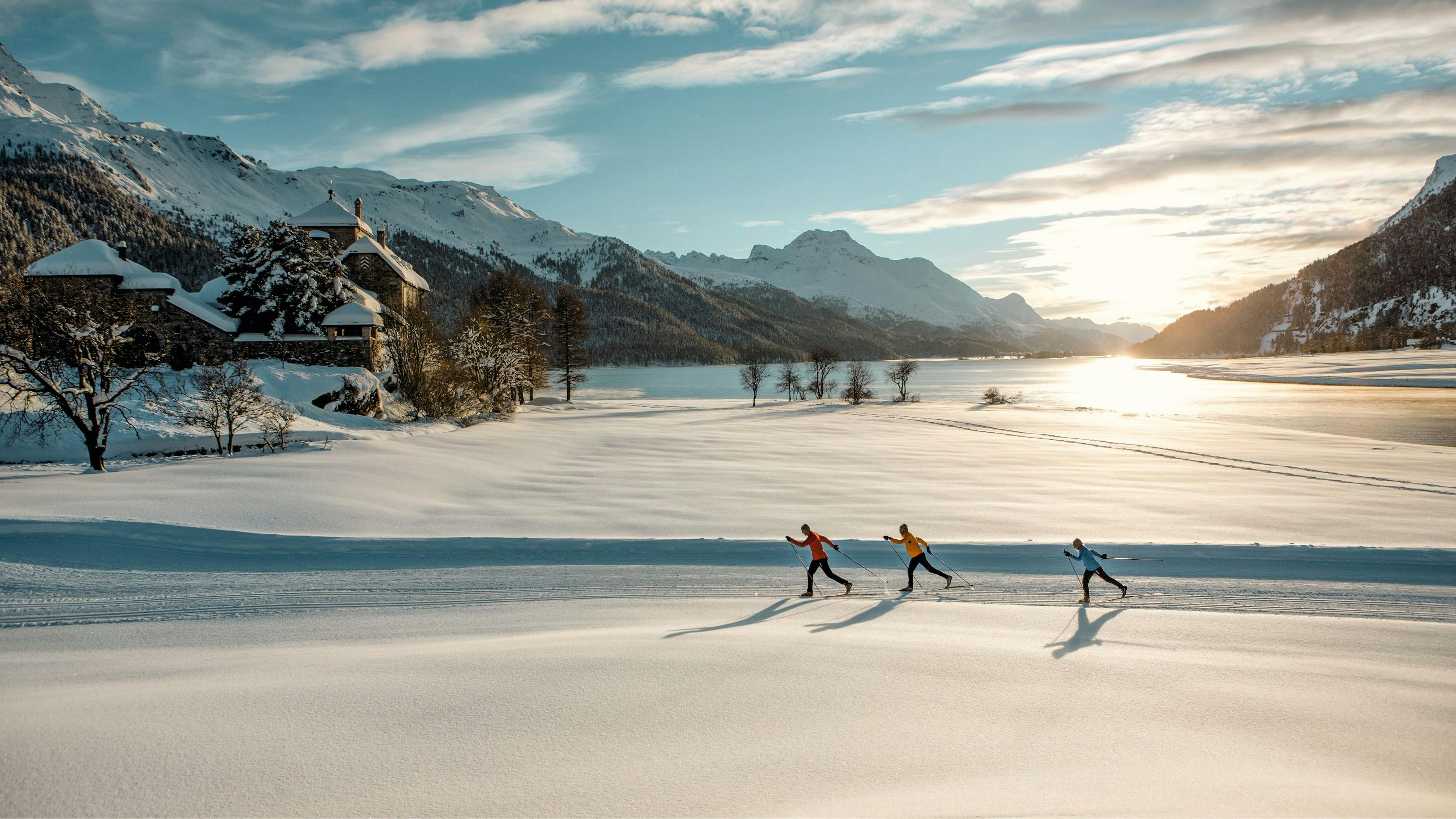
7 Activities
Filter
Better than 4.5 stars
Better than 4 stars
Better than 3.5 stars
Better than 3 stars
No Rating

Cross-country skating taster package in Grindelwald
Duration: 1:45 hours

Private cross-country skiing lessons in St. Moritz
Duration: 1 hour, 2 hours, 3 hours, 4 hours, 5 hours, 6 hours or 7 hours
Why book with Swiss Activities?

Private cross-country ski lessons in Verbier
Duration: 2 hours, 3 hours or 6 hours

Private cross-country skiing lessons in Zermatt
Duration: 2 hours, 3 hours or 6 hours

Private cross-country skiing lessons Grindelwald
Duration: 2:30 hours

Private cross-country skiing course from Täsch near Zermatt
Validity: All day

Private Cross-Country Skiing Lessons in Gstaad
Duration: 3 hours, 5 hours or 7:30 hours

Course
Cross-country skating taster package in Grindelwald
Duration: 1:45 hours
booked 14 times

Course
Private cross-country skiing lessons in St. Moritz
Duration: 1 hour, 2 hours, 3 hours, 4 hours, 5 hours, 6 hours or 7 hours
Why book with Swiss Activities?

Course
Private cross-country ski lessons in Verbier
Duration: 2 hours, 3 hours or 6 hours
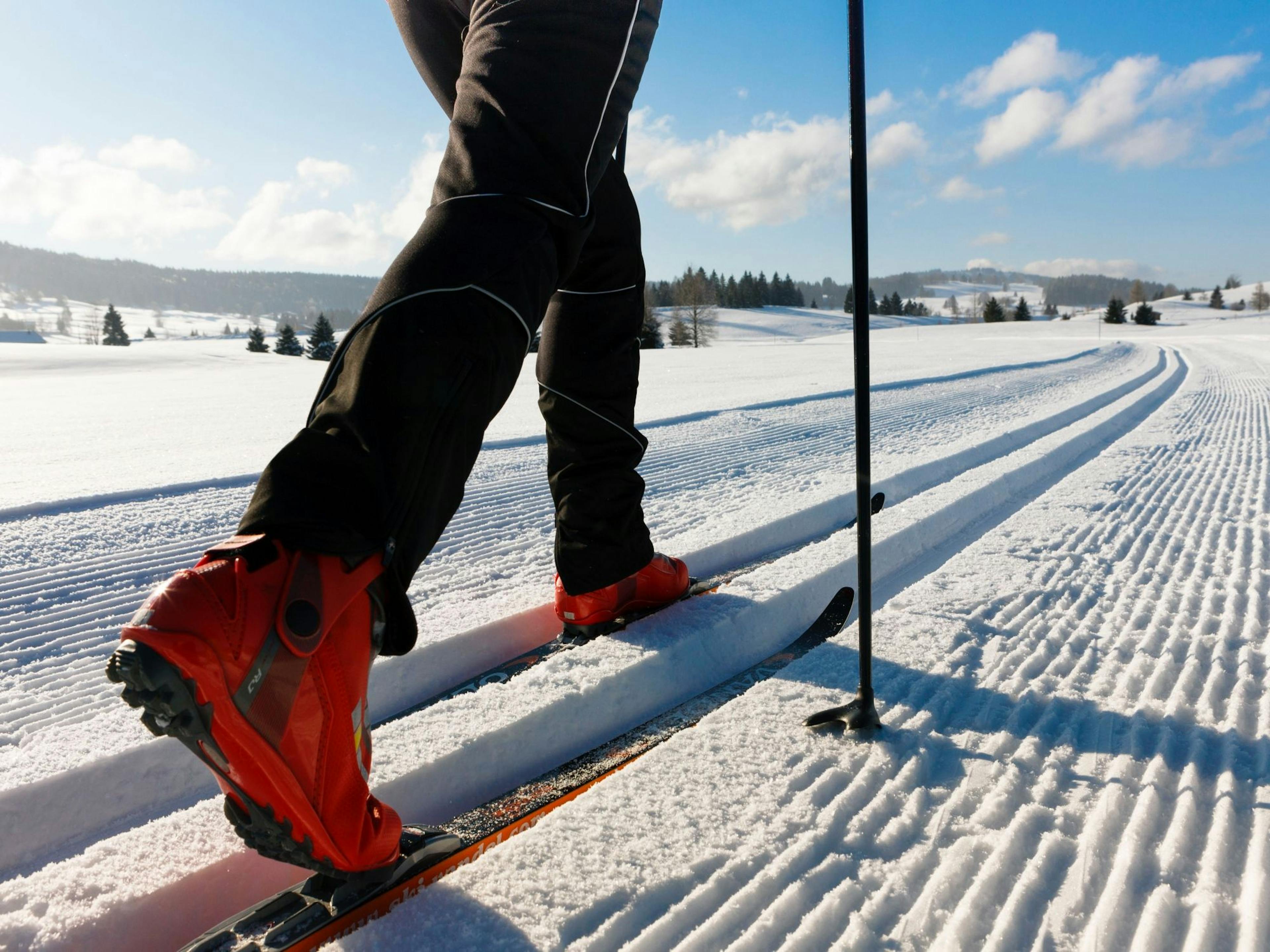
Course
Private cross-country skiing lessons in Zermatt
Duration: 2 hours, 3 hours or 6 hours

Course
Private cross-country skiing lessons Grindelwald
Duration: 2:30 hours
booked 5 times
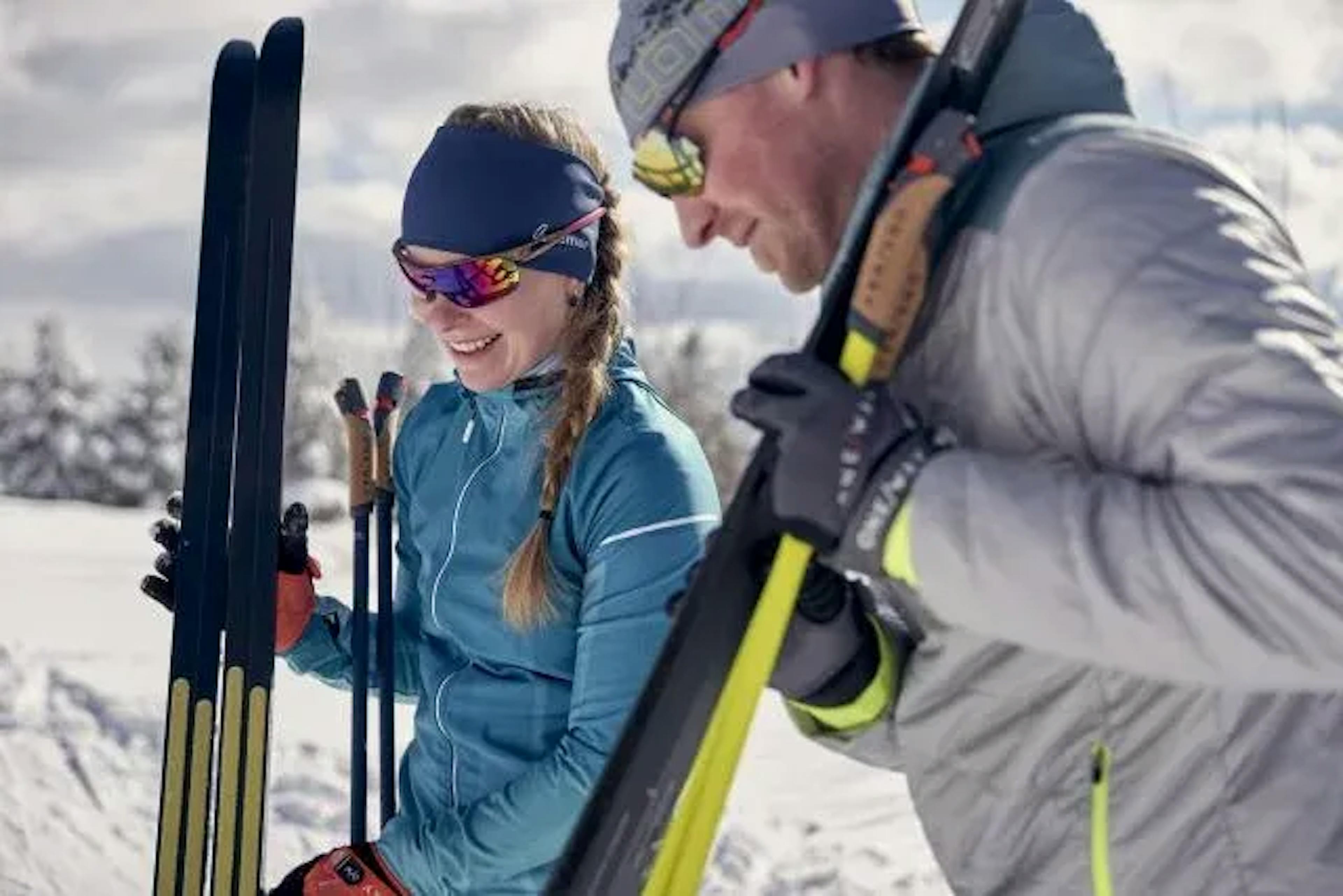
Course
Private cross-country skiing course from Täsch near Zermatt

Course
Private Cross-Country Skiing Lessons in Gstaad
Duration: 3 hours, 5 hours or 7:30 hours
With over 5,000 kilometers of trails, Switzerland offers more than enough opportunities for cross-country skiing. From the Engadine, where the Engadine Cross-Country Marathon takes place every year, to the panoramic trails in the Bernese Oberland, to the rolling hills of the Jura, you'll find something suitable in every corner
The lengths of the trails are as varied as the landscapes through which they wind. You'll encounter short cross-country trails in Switzerland starting at one kilometer that go for an extended loop around a sports field, or you'll head to a ski resort where more than 200 km of groomed trails await you.
In this guide we will lead you through the world of cross-country skiing in Switzerland. In addition to the most important basic skills, we will introduce you to some beautiful areas where you can practice your swing
Cross-country skiing is done in two styles: Classic and Skating
In the classic diagonal technique, the skis are guided in parallel. It takes place in dynamic alternation between gliding and pushing off. In diagonal stride, arms and legs move in opposite directions. The swing leg and a powerful pole drive you forward. The double pole push is used on sloping or flat terrain.
In this type of cross-country skiing, you are on a groomed trail with your skis moving as if in a track. Beginners are recommended to start with this type of skiing as it is considered easier than skating.
In skating you move forward similar to skating. This technique is more demanding and strenuous. With skating skis you reach higher speeds than on a classic cross-country ski. This is due to the use of force from the sliding edge of the skis
While the push-off and gliding phases alternate dynamically, the body's center of gravity shifts constantly. You usually use the poles with double pole thrust.
A good skating ski is suitable for both groomed trails and skating on rolled snow surfaces. The skis are usually between 1.85 m and 1.95 m long. Getting started with skating is easier if you start with the shorter ski
 Langlauf Grindelwald (Foto: Grindelwaldsports AG)
Langlauf Grindelwald (Foto: Grindelwaldsports AG) Langlauf Grindelwald (Foto: Grindelwaldsports AG)
Langlauf Grindelwald (Foto: Grindelwaldsports AG)The longest cross-country skiing trails in Switzerland are listed in this table.
| Trail name | Tourist region | Altitude (m a.s.l.) | Classic cross-country skiing (km) | Skating cross-country skiing (km) |
|---|---|---|---|---|
| Engadin | Grisons | 1450 - 1800 | 247 | 235 |
| Goms | Valais | 1250 - 1560 | 94 | 94 |
| Davos | Grisons | 1480 - 1860 | 76 | 56 |
| Les Rasses/Sainte-Croix | Lake Geneva-Waadtland | 1175 - 1300 | 65 | 65 |
| Evolène-Les Haudères/Arolla | Valais | 1370 - 2000 | 60 | 60 |
| Pontresina | Grisons | 1770 - 2200 | 57 | 57 |
| Lenz - Lenzerheide - Parpan | Grisons | 1360 - 1560 | 56 | 56 |
| Kandersteg | Bern | 1176 | 55 | 52 |
| La Vue des Alpes/Tête de Ran | Jura & Three Lakes Country | 1130 - 1360 | 54 | 54 |
| Escholzmatt-Marbach-Bumbach | Lucerne-Lake Lucerne | 850 - 920 | 50 | 50 |
| Les Cernets/Les Verrières | Jura & Three Lakes Country | 1150 - 1300 | 50 | 50 |
| Les Prés-d'Orvin/Chasseral | Berne | 1020 - 1540 | 50 | 50 |
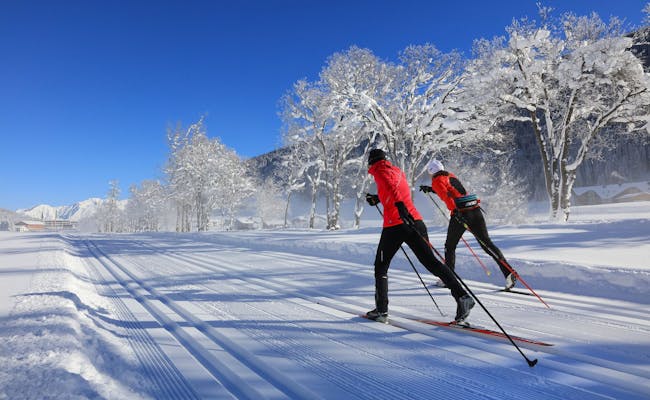 Langlauf Davos (Foto: MySwitzerland)
Langlauf Davos (Foto: MySwitzerland)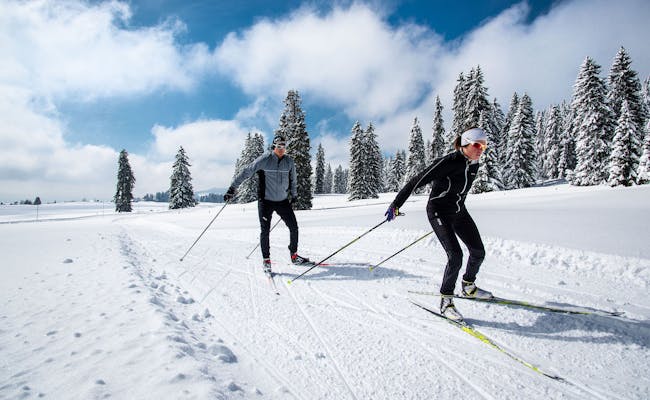 Langlauf Sainte Croix (Foto: MySwitzerland)
Langlauf Sainte Croix (Foto: MySwitzerland)There are a few questions about this popular sport that we are happy to answer.
Cross-country skiing is a suitable winter sport for young and old. The movements train the body in a holistic way, which helps to build up muscles quickly. You can go cross-country skiing with the whole family and even the dog will be happy to join you
You alone determine the intensity. Young and ambitious cross-country skiers can work intensively and systematically towards an increase in performance. For the pleasure skier it is enough to be in the nature and to move
Cross-country skiing is a holistic sport and is considered very healthy. Injuries are rare. Your legs and arms, as well as your torso, are constantly being stressed, which promotes flexibility and muscle development. Due to the gliding in the cross-country track, classic cross-country skiing has a gentle effect and there is no upsetting strain.
As in any discipline, the same applies to cross-country skiing: Practice makes perfect. The sport is fundamentally different from alpine skiing. The skis are much narrower and have hardly any edges to help you navigate. That's why it's worth taking a course for your first attempts.
Gliding forward is similar to inline skating. The use of poles is reminiscent of Nordic walking. The movement sequences on the boards are rather complex. The best conditions for learning cross-country skiing are elasticity, strength and endurance. After all, you need to transfer the power from your legs to the skis.
What both styles of cross-country skiing have in common is the challenge of downhill skiing and braking. Cross-country skis are very thin and don't have sharp edges like "normal" skis
Whenever possible, try to stand loosely on your skis and don't tense up. You should never guide your poles with the tips pointing forward out of fear. Some beginners try to brake in this way. This is highly dangerous and can lead to serious injuries.
To brake in the classic style, it is enough to take one ski out of the track. You turn the rear end of the ski outward. The tip of the ski points inwards and the body's center of gravity rests on the other leg. Finally, you apply appropriate pressure to the ski that is out and you can slow down. You try to keep your balance directly above the ski. The basic position for braking is parallel ski control and balance distribution
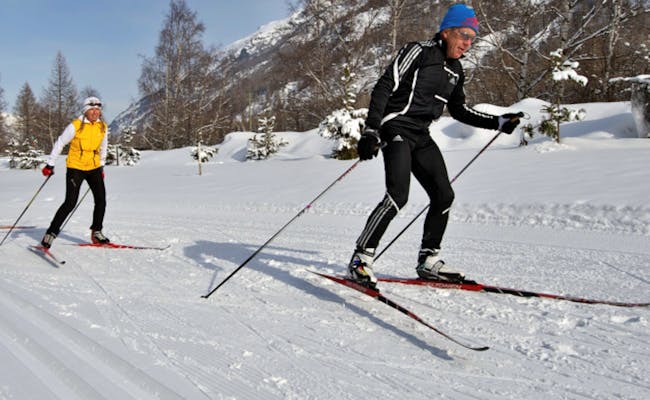 Langlauf Zermatt (Foto: Zermatters)
Langlauf Zermatt (Foto: Zermatters)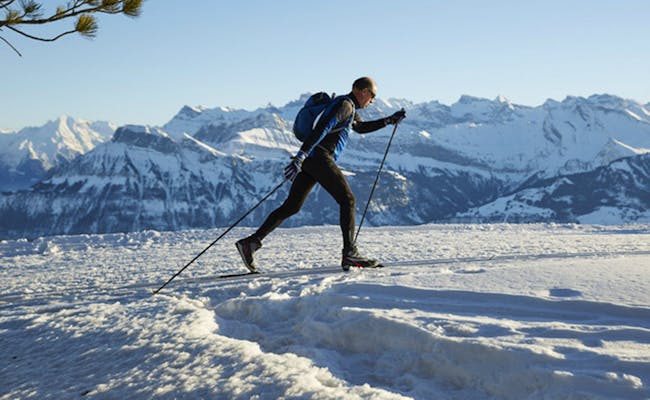 Langlauf Rigi (Foto: Rigi Bahnen)
Langlauf Rigi (Foto: Rigi Bahnen)Larger and smaller cross-country skiing areas with groomed trails can be found in all regions of Switzerland. Among the most attractive areas are the Jungfrau region, Valais and the canton of Grisons. In some cases, the trails are even open until 10:00 p.m. and illuminated with floodlights.
In the midst of a dreamlike landscape in the foothills of the Alps, beginners as well as professionals will get their money's worth on the cross-country skiing trail of the Studen cross-country skiing center. In addition to some sporting challenges, cross-country skiing on the wide plains is a real nature experience. The first three sections are flat and enjoyable trails and mostly sunny
The region between Lake Sihl and the Schwantenau moorland in central Switzerland is known for its picturesque scenery. Here the "Loipenmacher Schwedentritt" offer classic cross-country skiing and skating on beautiful and prepared trails.
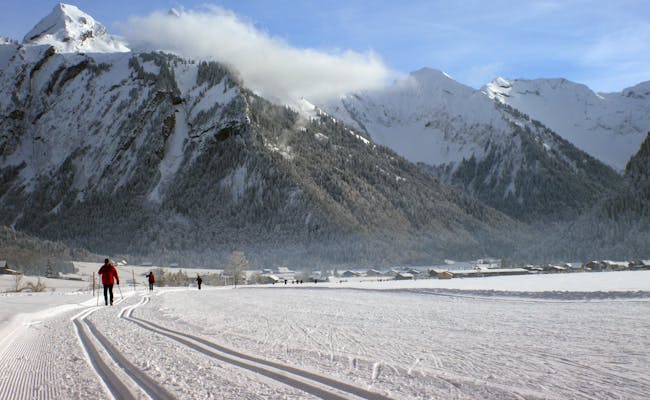 Langlauf Studen Ybrig (Foto: MySwitzerland)
Langlauf Studen Ybrig (Foto: MySwitzerland)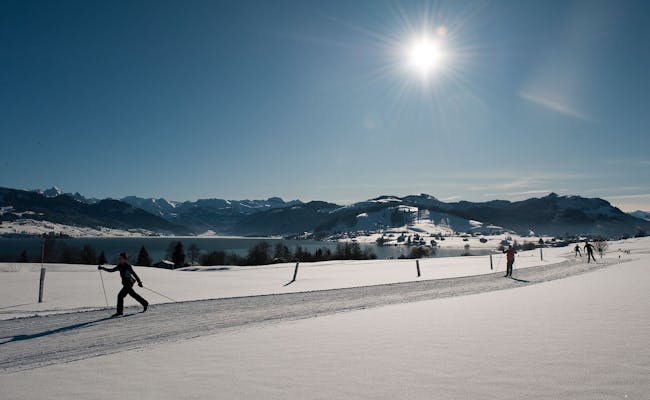 Langlauf Schwedentritt Einsiedeln (Foto: MySwitzerland)
Langlauf Schwedentritt Einsiedeln (Foto: MySwitzerland)The Andermatt Cross-country trails are situated in a beautiful high valley and lead via Hospental to Realp. With good snow conditions, it is possible to cross-country ski through the winter landscape as early as the beginning of December.
In the Upper Valais, a beautiful cross-country trail leads through the winter wonderland of Goms. The sunny high valley at the foot of the Rhone glacier is a popular meeting place for Nordic winter sports enthusiasts. The cross-country skiing network connects twelve villages on over 100 kilometers of trails.
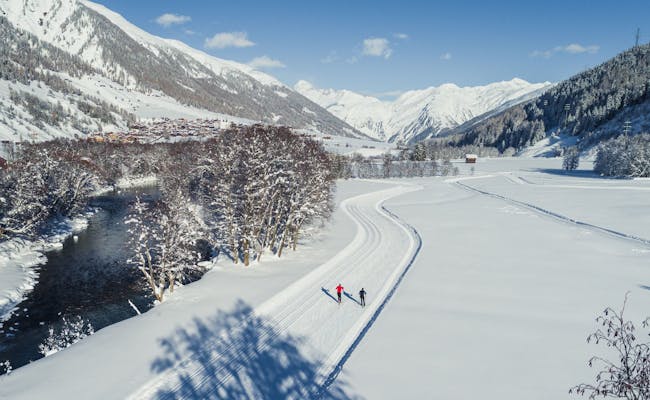 Langlauf Goms (Foto: MySwitzerland)
Langlauf Goms (Foto: MySwitzerland) Langlauf Andermatt (Foto: MySwitzerland)
Langlauf Andermatt (Foto: MySwitzerland)Davos is the highest town in the Alps and attracts with the slogan "from the piste to the slopes". Here, cross-country skiers make their tracks through romantic side valleys. There are trails of all levels of difficulty. The smaller, sunny Madrisa ski area is perfect for beginners.
The Engadine is home to the largest cross-country skiing network in Switzerland. The entire ski region around Pontresina offers cross-country skiers a winter sports paradise. The side valleys of Roseg and Morteratsch in particular offer a very special flair.
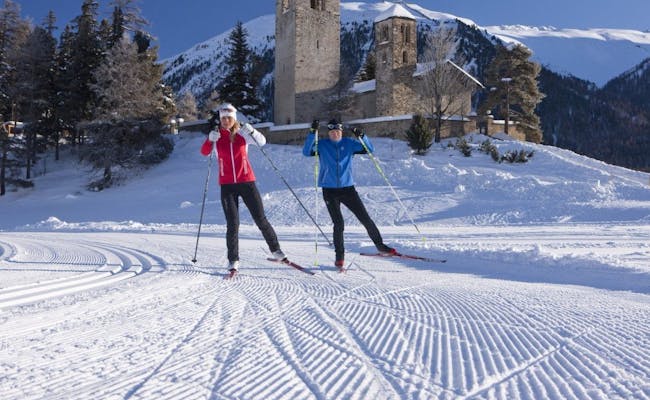 Langlauf Celerina (Foto: Graubünden Ferien Christof Sonderegger)
Langlauf Celerina (Foto: Graubünden Ferien Christof Sonderegger)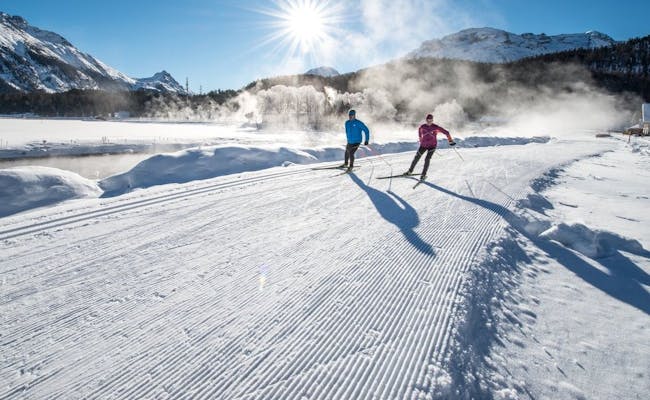 Langlauf Celerina (Foto: Graubünden Ferien Romano Salis)
Langlauf Celerina (Foto: Graubünden Ferien Romano Salis)With more than 50 kilometers of cross-country trails, Kandersteg is one of the larger cross-country skiing areas in Switzerland. Here everyone will find the right cross-country trail for them. The laps on the illuminated night trail are particularly beautiful. You can also enjoy pure cross-country skiing pleasure on the high-altitude trails with sun terrace.
In the beautiful foothills of the Alps in the Gantrisch Nature Park you can indulge in wonderful cross-country skiing. Here you can do your rounds at the gates of Bern and Fribourg. You can enjoy a spectacular panorama with a view of the Eiger, Mönch and Jungfrau.
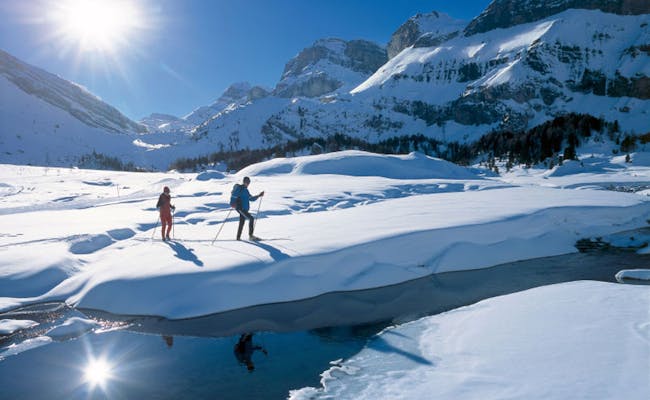 Langlauf Kandersteg Lötschberg (Foto: MySwitzerland)
Langlauf Kandersteg Lötschberg (Foto: MySwitzerland) Langlauf Gantrisch (Foto: MySwitzerland)
Langlauf Gantrisch (Foto: MySwitzerland)The Gais cross-country skiing center presents itself with a very beautiful view of the Alpstein. The route leads through sparse forests and over gentle hills. You roam along snow-covered meadows and moors. The area is characterized by short ascents and easy descents. It ensures cross-country skiing fun for young and old.
With the Wetterhorn in front of your eyes and the Eiger breathing down your neck, you'll experience natural motivation on this route. Against a fabulous backdrop, the varied route leads through forests and over wide-open spaces. Grindelwald scores with a dreamlike panorama in the middle of the Jungfrau region.
 Langlauf Grindelwald (Foto: Grindelwaldsports AG)
Langlauf Grindelwald (Foto: Grindelwaldsports AG)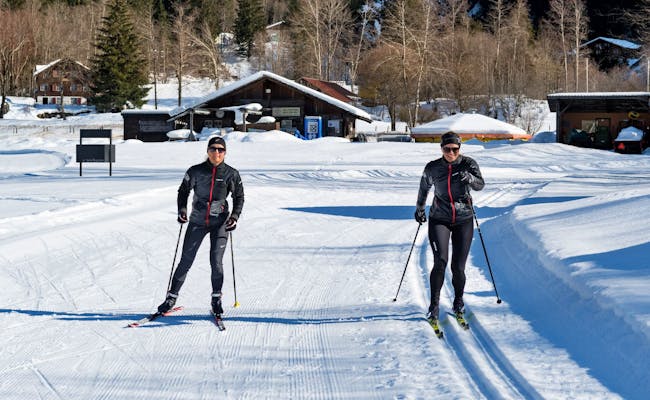 Langlauf Grindelwald (Foto: Grindelwaldsports AG)
Langlauf Grindelwald (Foto: Grindelwaldsports AG)To learn cross-country skiing, children should be at least four years old. Most children learn by watching and walking along. Nevertheless, it is recommended to attend a course in the beginning
Five years old is the perfect age for children to start. Courses are offered for both classic cross-country skiing and skating. Young children dare their first attempts on classic skis. It is not until the age of eight that skating courses make sense.
The little ones can practice and improve their cross-country technique at numerous stations in the winter sports resorts. The courses can be skied with classic cross-country skis as well as with skating skis.
As a cross-country skier, you should always hit the trails with the right equipment, attitude and technique. Cross-country skiing is a safe sport. The risk of injury is much lower than other winter sports such as skiing or sledding. And yet there are some important points to consider
When buying cross-country equipment, a competent and individual consultation in a good sports store is highly recommended. Here you will find the most important features of good equipment at a glance
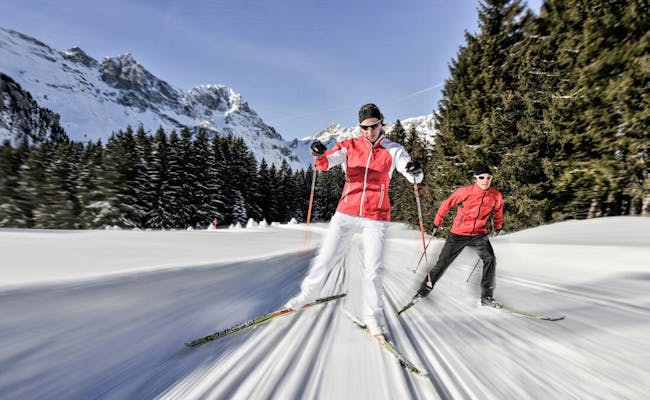 Langlauf Titlis (Foto: Titlis Bergbahnen)
Langlauf Titlis (Foto: Titlis Bergbahnen) Langlauf Titlis (Foto: Titlis Bergbahnen)
Langlauf Titlis (Foto: Titlis Bergbahnen)The skis are about the size of the body and the poles reach no more than under the armpits. The specifications of the official tables are based on the weight of the children. For example, for a body weight of up to 25 kg, a ski length of 110 cm is recommended. For a body weight between 35 and 39 kg, the recommended ski length is 140 cm. Between 48 and 54 kg, the ideal length is 170 cm.
In addition, the poles should always have a small plate. The pole is otherwise too heavy. With the clothes it behaves like with the adults. The shoes should not be too small and the socks not too thick. With a snowsuit, the little ones are dressed for cross-country skiing.
Beginners and occasional skiers can rent skis and poles at sports stores and on site. This is a good way to try out which technique suits you better. Only with perfectly matched rental equipment you will experience maximum fun in the snow.
Based on your ability and the respective skiing style, you will benefit from the professional service of a well-trained team. The daily prices for cross-country skis vary between 22 and 32 CHF, depending on the model.
Cross-country skiing in Switzerland is a sport that you can practice in all regions. It strengthens strength and endurance and has the advantage that you can really enjoy the landscape.